America’s ‘sinkhole alley’ – where roads cave in, homes are swallowed whole and people vanish into the void beneath
Central Florida is also known as “Sinkhole Alley” because the area has become infamous for the dangerous phenomenon where the ground collapses without warning, putting nearby homes and businesses in grave danger.
Many residents of the state are still haunted by a serious incident that occurred in 1981 at a car dealership in Lake Rose, with some vehicles still lying beneath the surface.
Dr. Manoj Chopra, a sinkhole and erosion expert from the University of Central Florida, spoke with ClickOrlando this week about the prevalence of sinkholes in the state and why they form.
Chopra says “Sinkhole Alley” covers a huge swath of land in Florida, “going all the way from Hillsborough County, near Tampa, all the way up to Daytona and through our areas of Maitland and Winter Park.”
Of the nearly 27,000 sinkholes reported in Florida, 20,145 dangerous holes are located in the three counties of Sinkhole Alley: Pasco, Hernando and Hillsborough.
Central Florida has been dubbed ‘Sinkhole Alley’ after it became infamous for the dangerous phenomenon where the ground suddenly collapses. Pictured: A car being pulled into a sinkhole in Florida
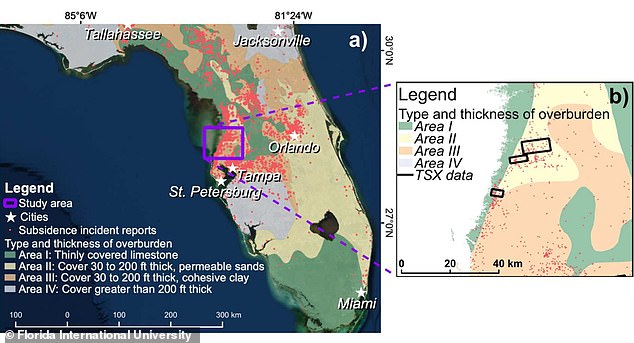
Dr. Manoj Chopra, a sinkhole and erosion expert from the University of Central Florida, explained the prevalence of sinkholes in Central Florida
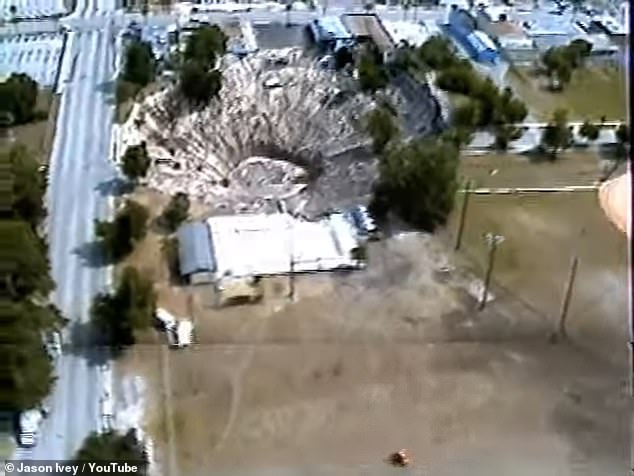
Aerial footage from 1981 shows a large sinkhole in Winter Park, Florida, which caused the collapse of a car dealership, leaving vehicles submerged to this day
Chopra highlighted the devastation that the infamous 1981 sinkhole in Winter Park near Orlando that grew to a diameter of 400 feet (122 meters) and swallowed five cars, two businesses, a three-bedroom home, nearby streets and the deep end of an Olympic-size swimming pool.
Many sinkholes eventually become picturesque lakes. Chopra explained how to easily spot them from above.
“If you fly over Central Florida and you see those round lakes, they’re probably sinkholes. A sinkhole is usually a funnel that drops out of the water’s surface and collapses into it,” Chopra said.
Although they look beautiful from above, in reality they pose a major threat to the safety of the local population.
Perhaps most disturbing is that some sinkholes appear to occur seemingly at random.
While sinkholes that form under sandy soil typically show danger signs in their surface depressions before they collapse, sinkholes that begin to crumble under clay layers, such as the deadly incident in Seffner, can collapse suddenly and without warning.
In 2013, 37-year-old Seffner resident Jeff Bush was sleeping when he was unexpectedly swallowed by a sinkhole. Rescuers were unable to recover his body after it sank into the void below.
Chopra said the clay acts as a barrier, hiding the erosion that eats away beneath the surface until the clay implodes, taking everything above it with it.
In 2018, dozens of sinkholes opened in a Florida town, forcing the evacuation of eight homes and raising fears that other residents would be forced to leave as well.
The holes formed around a retention pond in Ocala’s Wynchase neighborhood and continued to form for two weeks, leaving locals baffled and terrified about the underlying cause.
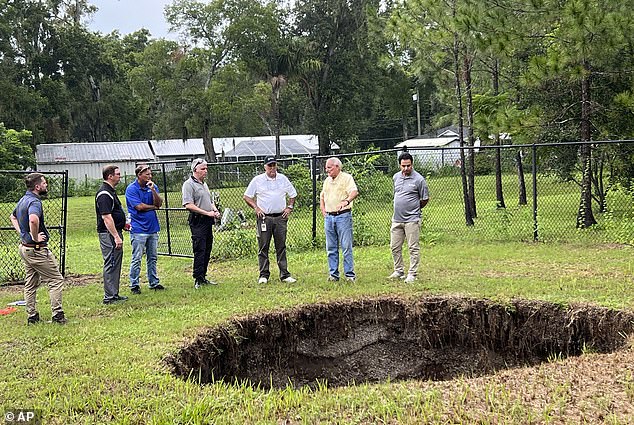
This photo shows a sinkhole that fatally swallowed a sleeping man in his own home in 2013. The sinkhole has reopened for the third time, this time behind a chain-link fence and with no damage to people or property.
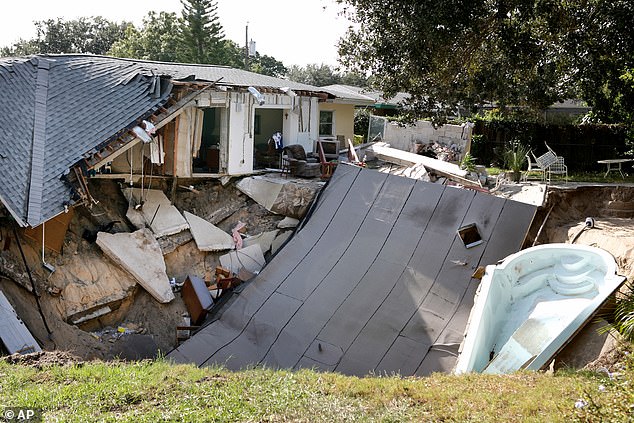
A home is destroyed after the backyard behind the house collapsed and became a sinkhole, taking with it their deck and boat in November 2013 in Dunedin, Florida
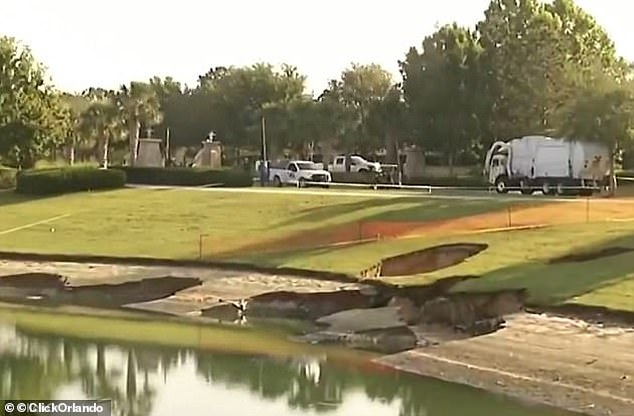
In 2018, a dozen sinkholes opened in a Florida town, forcing the evacuation of eight homes and raising fears among other residents that they would be the next to leave.
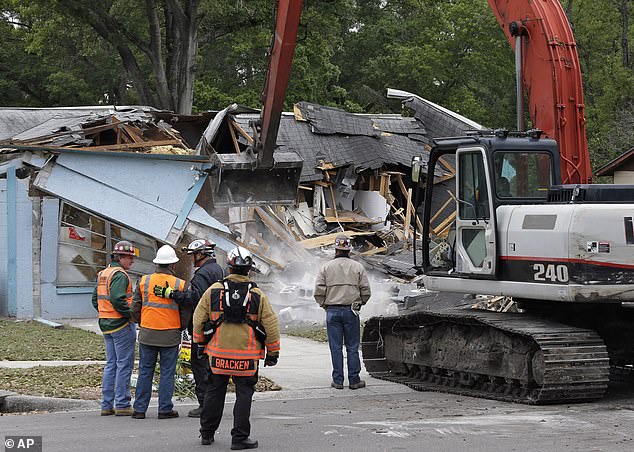
Demolition experts watch as the home is destroyed after a sinkhole opened late that evening, swallowing Bush, 37, in Seffner on March 3, 2013.
“They just keep coming,” local resident Maren Pinder told WFTV at the time. “Are we safe? We don’t know. It’s really scary. We just have a bag ready in case we get told to evacuate.”
Some sinkholes can remain unused for decades before inevitably growing larger and causing further damage.
In 2023, the deadly Seffner sinkhole, which previously killed a sleeping Florida man, returned for the third time.
Since Bush’s death, the sinkhole has been surrounded by a chain-link fence. The move is intended to protect residents of the Tampa suburb from further harm and serves as a warning of the hole’s destructive power.
In an attempt in 2015, after the hole was opened for the second time, it was filled with a mixture of gravel and water.
At its widest, however, the sinkhole was 19 feet (5.8 meters). State records show that sinkholes in Florida can grow as wide as 400 feet (121 meters), swallowing cars and businesses and, in one case in 2006, draining nearby Scott Lake.
One sinkhole in Emerald Springs, Mystery Sink, infamous for the loss of two lives, has been permanently closed to the public. A large barbed wire fence now surrounds the area.
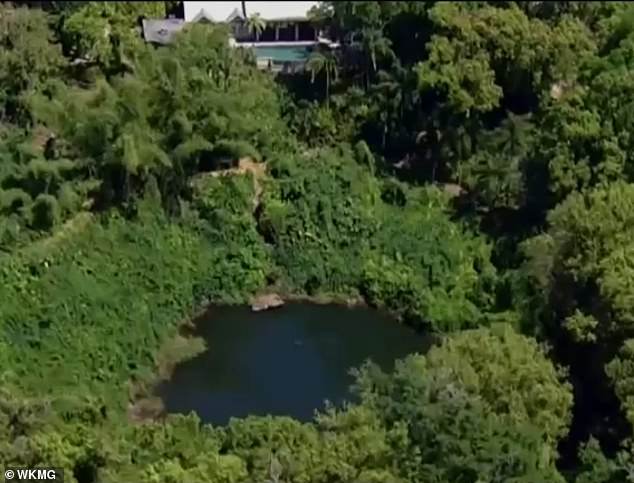
Pictured: The deadly Mystery Sink where two people lost their lives within days
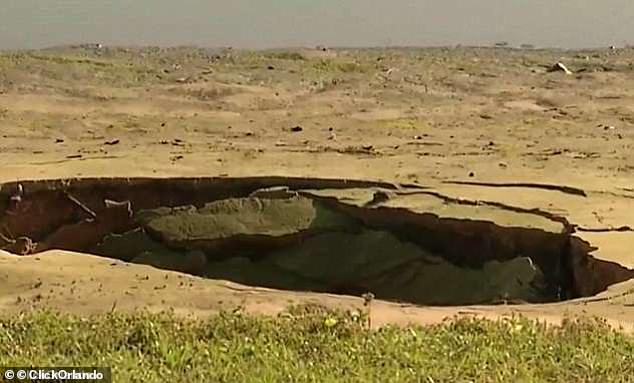
Central Florida has been nicknamed “Sinkhole Alley” because it has become infamous for the dangerous phenomenon where the ground suddenly collapses
In 1970, a 16-year-old Orlando boy named Fred Schmidt went diving with local instructor Hal Watts in the lake known for its deep-water diving lessons.
The pair went to Mystery Sink in search of a lost safety vest, but disaster struck when Watts realized the teenager was no longer with him.
Although Watts saw the boy briefly below him, he was unable to find him again before he passed out.
Three days after the search for the boy’s body began, disaster struck again when diver Bud Sims, who was helping with the operation, became entangled in search lines and panicked, losing his tooth while trying to surface.
Tragically, Sims crashed into the hull of a TV boat and died before he could be rescued.
Despite efforts to recover the bodies, neither the teenager’s nor Sims’ remains were ever found.
When it comes to prevention, Chopra urges homeowners to understand the geologic history of their neighborhood.
He also advised consulting the Florida Geological Survey’s sinkhole map to assess the risk level of a particular location.
But at some point, avoiding Florida’s nearly 30,000 sinkholes may be a matter of luck.
